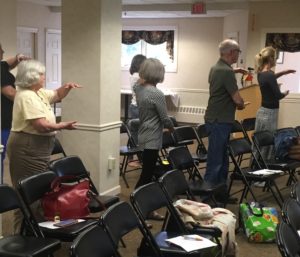Falling Is Serious Risk for Seniors, but Exercise Helps
 The statistics about falls involving senior citizens are troubling: According to the Centers for Disease Control and Prevention, 1 in 4 adults 65 and older fall each year, and the numbers are rising.
The statistics about falls involving senior citizens are troubling: According to the Centers for Disease Control and Prevention, 1 in 4 adults 65 and older fall each year, and the numbers are rising.
There’s more: Every 20 minutes an older adult dies because of a fall (more than 27,000 a year), 1 in 5 falls cause a serious injury and 7 million falls required some form of medical treatment. These CDC statistics from 2014, the most recent year available, have led to the growing concern from health care providers and others who work with senior citizens.
By Liz Sauchelli, Valley News Calendar Editor and Sunday Seniors Feature Writer
Published by the Valley News on Sunday, September 23, 2018. Reprinted with permission.
Saturday was the National Council on Aging’s annual Falls Prevention Awareness Day, but it’s a topic that should be on our radar every day.
“Even though it’s very common, we know it’s under reported,” said, Dawna Pidgeon, a physical therapist at Dartmouth-Hitchcock Medical Center, during a presentation to the Aging in Community Forum quarterly meeting last week.
“We need everybody,” to help reduce falls, said Pidgeon, who is part of the Dartmouth Centers for Health Aging Falls Team.
A fall, in general terms, is described as “unintentionally coming into contact with the floor or a lower service,” Pidgeon said. Hip fractures from falls are of particular concern, because many senior citizens who have them never fully recover, according to the CDC. But it’s important to note that many of the intrinsic and extrinsic factors that contribute to falls can be addressed.
Intrinsic causes include:
- muscle weakness
- dizziness
- poor vision
- fear of falling
- gait/balance issues
Extrinsic causes include:
- the use of four of more medications
- alcohol use
- wearing poorly fitting shoes
Dizziness Is Never Normal
“Dizziness is never normal,” Pidgeon said. “If people are dizzy, we want to make sure we’re getting them help for it.”
When it comes to preventing falls, there’s one tactic that takes precedence. “Of all the things we can do, exercise is the most important,” Pidgeon said. “The exercise has to be balance and strengthening exercises.”
While people naturally start to lose muscle fiber as they age, the goal is to strengthen the muscle that remains. “We also know you can always increase the size of the muscle fibers you do have,” Pidgeon said.
She is a certified trainer for Tai Ji Quan: Moving for Better Balance, a program that studies have shown helps improve balance and prevent falls among senior citizens. “The results are phenomenal,” Pidgeon said. “They build their strength and their confidence.” Another program, A Matter of Balance, has had similar results.
One challenge is getting people to participate in the programs. Ti Ji Quan, for example, requires seniors to attend class twice a week for 24 weeks. A Matter of Balance asks attendees for two hours each week for eight weeks.
Balance Screening Can Be First Step
Another way to get people started on these courses is to do balance screenings, which health care providers and organizations can provide. DHMC’s Aging Resource Center, for example, hosts free balance screenings from 9:30 a.m. to 11:30 a.m. on the first and second Wednesdays of every month.
Other steps people can take to minimize fall risks, according to the CDC, including clearing clutter from floor, adding grab bars in bathrooms and handrails on stairs, removing throw rugs and keeping areas well lit.
Editor’s note: For more information about falls prevention, visit https://www.cdc.gov/steadi/.
Liz Sauchelli can be reached at esauchelli@vnews.com or 603-727-3221.




Leave a Reply
Want to join the discussion?Feel free to contribute!